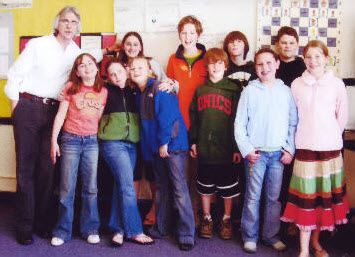
Soon after completing the inital draft of The Inventors’ Daughter– my first children’s novel – I met a conscientious and amiable teacher named Brian Williamson. We bumped into one another where I meet most of my friends, in a coffee shop in my neighborhood. When I mentioned the manuscript, he asked if a segment of his fifth-grade class could read the book and give me their opinions. I was thrilled. Here was the perfect readers group for a book aimed at 9 to 12 year-olds.
Six weeks later Brian and his students ate our brown-bag lunches around a venerable, well-worn work table in the school’s art room. As you can see from the photo, the students were a fun, lively lot. But as the discussion of the book moved around the table, I could see that they were intelligent and focused as well. From some, the remarks flowed freely. A few needed a bit of encouragement from Brian. But in no time, they too were giving me valuable commentaries on what they found funny, exciting or confusing.
The gratifying thing for me and Brian was that all of the students read the entire manuscript judiciously. And from their comments, I’m certain that I got more from these bright kids than I would have received from a my own writers’ group, however well-meaning, who would have been trying to second-guess my actual audience.
Two comments stood out in particular:
One girl said twice – with deep sincerity – that “the story must flow.” Other’s nodded. It was then I realized that, having been accustomed to writing screenplays which are scenic in nature, I had not acquired the skill of writing the smooth, corherent monologue that is the narrative of a novel. Scripts are shocks of dialog and an sparce, choppy narrative written for a host of artistic and technical people searching for their own assignments detailed within its text. A novel is something else altogether.
My second revalation was that some things were unclear to my readers. In an effort to conceal the skeleton of the mystery on which my plot hangs, my story had murky spots. A rule I learned in the University of Washington literary fiction program is that you must never describe something as “indescribable.” It is the duty of the writer to describe a character’s perception of anything – even a phantom.
With those two gems, I returned to my story and did my best to polish the manuscript into something my audience could understand and enjoy. My special thanks to Mr. Williamson’s readers’ group.

